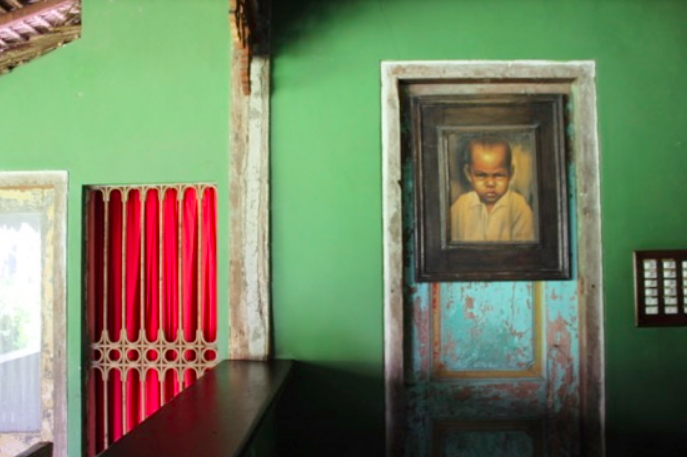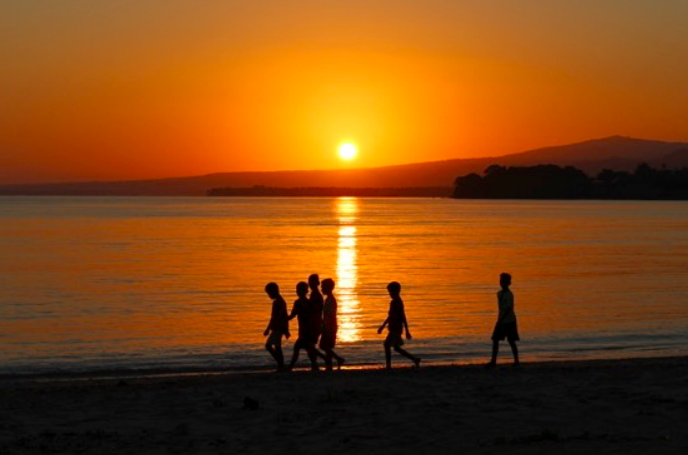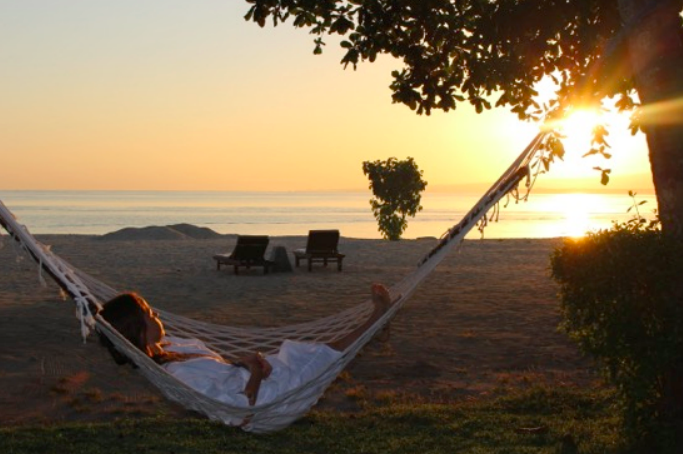UNRAVELING LOMBOK’S HISTORY IN THE TRANQUIL ARMS OF
LUXURY
THIS ARTICLE WAS WRITTEN FOR AND PUBLISHED BY HELLO BALI MAGAZINE
The island of Lombok might be busy establishing itself as a standalone international destination, but that doesn’t seem to disrupt its increasing popularity as a side trip from Bali. It is rarely the first pick on the offshore list; the closer Lembongan and Gili Islands offer all the trademarks of a tropical postcard, and their small land size offer trips of ease.
So why even consider taking the boat that little bit further – bypassing lively beach bars, glamorous accommodation, and manta ray dive sites – only to find yourself navigating the complexities of a sprawling, largely undeveloped island? To delve into untapped territories. To witness the occasional reminder of a long forgotten history. To peel back layers of a dynamic religious influence. And to find a perfect state of equanimity. That’s why.
The island of Lombok might be busy establishing itself as a standalone international destination, but that doesn’t seem to disrupt its increasing popularity as a side trip from Bali. It is rarely the first pick on the offshore list; the closer Lembongan and Gili Islands offer all the trademarks of a tropical postcard, and their small land size offer trips of ease.
So why even consider taking the boat that little bit further – bypassing lively beach bars, glamorous accommodation, and manta ray dive sites – only to find yourself navigating the complexities of a sprawling, largely undeveloped island? To delve into untapped territories. To witness the occasional reminder of a long forgotten history. To peel back layers of a dynamic religious influence. And to find a perfect state of equanimity. That’s why.
THE AWE OF AN ART HOTEL
Lombok’s Hotel Tugu sits an hour north of the Teluk Kode boat dock. It is one in a collective of four independently owned art hotels founded by Anhar Setjadibrata, the holder of the country’s largest collection of Indonesian fine art and cultural antiquities. Here in the hotel’s tranquil arms of luxury, a rare opportunity presents itself to uncover realms of history and culture without leaving the comfort of your accommodation. In one small pocket of North West Lombok, the depths of Lombok can be uncovered.
Revered as a union of religion, Tugu Lombok reflects the labyrinth of diverse religious villages on the island, spanning Buddhism, Muslim, and Chinese Peranakan. Shrouded in chapters of ancient Hindu manuscripts of the Mahabharata, homage is paid to a time long before invasion, famine and riots hit Lombok, when Hinduism reined supreme. Even the hotel’s spa sings to the tune of Borobudur, a Buddhist temple in Central Java. We’re told of this religious harmony by our contented driver just moments before we enter the Tugu grounds.
Lombok’s Hotel Tugu sits an hour north of the Teluk Kode boat dock. It is one in a collective of four independently owned art hotels founded by Anhar Setjadibrata, the holder of the country’s largest collection of Indonesian fine art and cultural antiquities. Here in the hotel’s tranquil arms of luxury, a rare opportunity presents itself to uncover realms of history and culture without leaving the comfort of your accommodation. In one small pocket of North West Lombok, the depths of Lombok can be uncovered.
Revered as a union of religion, Tugu Lombok reflects the labyrinth of diverse religious villages on the island, spanning Buddhism, Muslim, and Chinese Peranakan. Shrouded in chapters of ancient Hindu manuscripts of the Mahabharata, homage is paid to a time long before invasion, famine and riots hit Lombok, when Hinduism reined supreme. Even the hotel’s spa sings to the tune of Borobudur, a Buddhist temple in Central Java. We’re told of this religious harmony by our contented driver just moments before we enter the Tugu grounds.
PRIVACY IS A PINNACLE
Inside the gates, a colossal masterpiece of deep scarlets and olive greens sits over a sprawling, perfectly manicured garden. Carved pillars stretch towards the 15-metre high thatched roof and an oversized lap pool create a grandeur feeling not frequently offered in the world of boutique.
After inhaling the magnificence of the lobby and dining area we’re escorted past the hotel’s private beach to our residence, the Puri Dadap Merah. This particular bedroom suite features a private massage room, a private rooftop terrace overlooking the ocean, and a private plunge pool – needless to say, privacy is a pinnacle.
Inside the gates, a colossal masterpiece of deep scarlets and olive greens sits over a sprawling, perfectly manicured garden. Carved pillars stretch towards the 15-metre high thatched roof and an oversized lap pool create a grandeur feeling not frequently offered in the world of boutique.
After inhaling the magnificence of the lobby and dining area we’re escorted past the hotel’s private beach to our residence, the Puri Dadap Merah. This particular bedroom suite features a private massage room, a private rooftop terrace overlooking the ocean, and a private plunge pool – needless to say, privacy is a pinnacle.
Honouring the architecture of Aksobya, an ancient temple visited by Javanese kings, the room is a museum of precious antiques set amongst walls printed with green leaves and a ceiling draped in silks. The level of eccentricity and exoticism seems unmatchable; yet somehow another 18 equally remarkable rooms exist.
We spend our days kayaking, collecting shells and euphorically musing over life whilst half submerged in iridescent water. The notion of time disappears and any veils of stress we arrived with are lifted. We’re drunk on the fortune of our flawless beach holiday. Finally, after what seems like an eternity but was probably mere days, we hear the call of the outside world and a trip to Mataram City is arranged.
We spend our days kayaking, collecting shells and euphorically musing over life whilst half submerged in iridescent water. The notion of time disappears and any veils of stress we arrived with are lifted. We’re drunk on the fortune of our flawless beach holiday. Finally, after what seems like an eternity but was probably mere days, we hear the call of the outside world and a trip to Mataram City is arranged.
MEANDERING IN SEARCH OF MOSQUES
Rumour has it there are over 600,000 mosques sprinkled across the 17,000 plus islands that make up the archipelago of Indonesia. Unlike the predominately Hindu Bali where mosques are an infrequent sight, Lombok hosts many of these impressive Islamic structures, even being coined The Land of A Thousand Mosques. Visiting at least one whilst on the island seemed only good manners.
Mataram, Lombok’s capital city, is currently acquiring an enormous Islamic Centre. It appears mysteriously on approach of the city like Aladdin’s castle, dripping in gold and intricate tiles and surround by empty fields. With no other visitors insight, we take in its regal beauty without distraction, ambling up half constructed stairs and spinning under the building’s main dome while it bounces around the echoes of our enthusiasm.
Rumour has it there are over 600,000 mosques sprinkled across the 17,000 plus islands that make up the archipelago of Indonesia. Unlike the predominately Hindu Bali where mosques are an infrequent sight, Lombok hosts many of these impressive Islamic structures, even being coined The Land of A Thousand Mosques. Visiting at least one whilst on the island seemed only good manners.
Mataram, Lombok’s capital city, is currently acquiring an enormous Islamic Centre. It appears mysteriously on approach of the city like Aladdin’s castle, dripping in gold and intricate tiles and surround by empty fields. With no other visitors insight, we take in its regal beauty without distraction, ambling up half constructed stairs and spinning under the building’s main dome while it bounces around the echoes of our enthusiasm.
Despite the marginal difference in the overall population density of Bali and Lombok, the population of Mataram is just 420,000 - precisely half that of Bali’s capital, Denpasar. Foreign tourists are few, and there is little to do aside from scrutinise the price tag of electrical goods at the Mataram Mall.
Still nauseated by the journey into town we head back to Tugu, attempting to justify the two-hour round-trip by the beauty of the Islamic Centre mosque. None of us care to discuss the activities we inexplicably traded off. Had we listened to the Tugu staff we would have been busy shucking pearls from gold-lipped oysters, bathing in waterfalls at the foot of Mount Rinjani or learning the traditional art of the Djamoe herbal elixir. Apparently some lessons need to be learnt the hard way.
Still nauseated by the journey into town we head back to Tugu, attempting to justify the two-hour round-trip by the beauty of the Islamic Centre mosque. None of us care to discuss the activities we inexplicably traded off. Had we listened to the Tugu staff we would have been busy shucking pearls from gold-lipped oysters, bathing in waterfalls at the foot of Mount Rinjani or learning the traditional art of the Djamoe herbal elixir. Apparently some lessons need to be learnt the hard way.
Back at Tugu, the sins of our ignorance are long forgotten over cacao scrubs and cocktails in our suite’s deep copper bathtub. Just as the sun’s setting, we head to one of the bamboo day beds that sit nesting on Sire Beach, just a few footsteps from our bedroom suite. As darkness falls an Indonesian feast is delivered, which we chow down by the light of the moon and an encircling of tea-light candles.
We leave Tugu well rested and reenergized to explore the diversity of the islands beyond Bali. Our driver weaves back down the bucolic coastline fringed by towering palm trees that defy all laws of gravity. He offers to stop so we can take a few photos but we decline. Satisfied and content, we know that no manner of photography skills will do this trip justice.
We leave Tugu well rested and reenergized to explore the diversity of the islands beyond Bali. Our driver weaves back down the bucolic coastline fringed by towering palm trees that defy all laws of gravity. He offers to stop so we can take a few photos but we decline. Satisfied and content, we know that no manner of photography skills will do this trip justice.
GETTING TO HOTEL TUGU LOMBOK FROM BALI
Direct flights between Denpasar and Mataram operate daily through Wings Air and Garuda Indonesia and take just under two hours. Boats from Padangbai to Bangsal operate right through the day and will cost you approximately 1 million IDR return.
STAYING AT HOTEL TUGU LOMBOK
For more information on staying at Tugu you can e-mail [email protected]. Rooms start from as little as $230 USD per night.
Jl. Pantai Sire, Desa Sigar Penjalin, Kecamatan Tanjung, Lombok Utara.
T: +62 37 061 20111
W: www.tuguhotels.com/hotels/lombok
WHEN TO GO
Escape Bali’s wet season and take a trip between October and April. Although the climate of Bali and Lombok are quite similar, the seasonal down pour in Lombok is usually far less and the humidity is more manageable.
Direct flights between Denpasar and Mataram operate daily through Wings Air and Garuda Indonesia and take just under two hours. Boats from Padangbai to Bangsal operate right through the day and will cost you approximately 1 million IDR return.
STAYING AT HOTEL TUGU LOMBOK
For more information on staying at Tugu you can e-mail [email protected]. Rooms start from as little as $230 USD per night.
Jl. Pantai Sire, Desa Sigar Penjalin, Kecamatan Tanjung, Lombok Utara.
T: +62 37 061 20111
W: www.tuguhotels.com/hotels/lombok
WHEN TO GO
Escape Bali’s wet season and take a trip between October and April. Although the climate of Bali and Lombok are quite similar, the seasonal down pour in Lombok is usually far less and the humidity is more manageable.







 RSS Feed
RSS Feed
